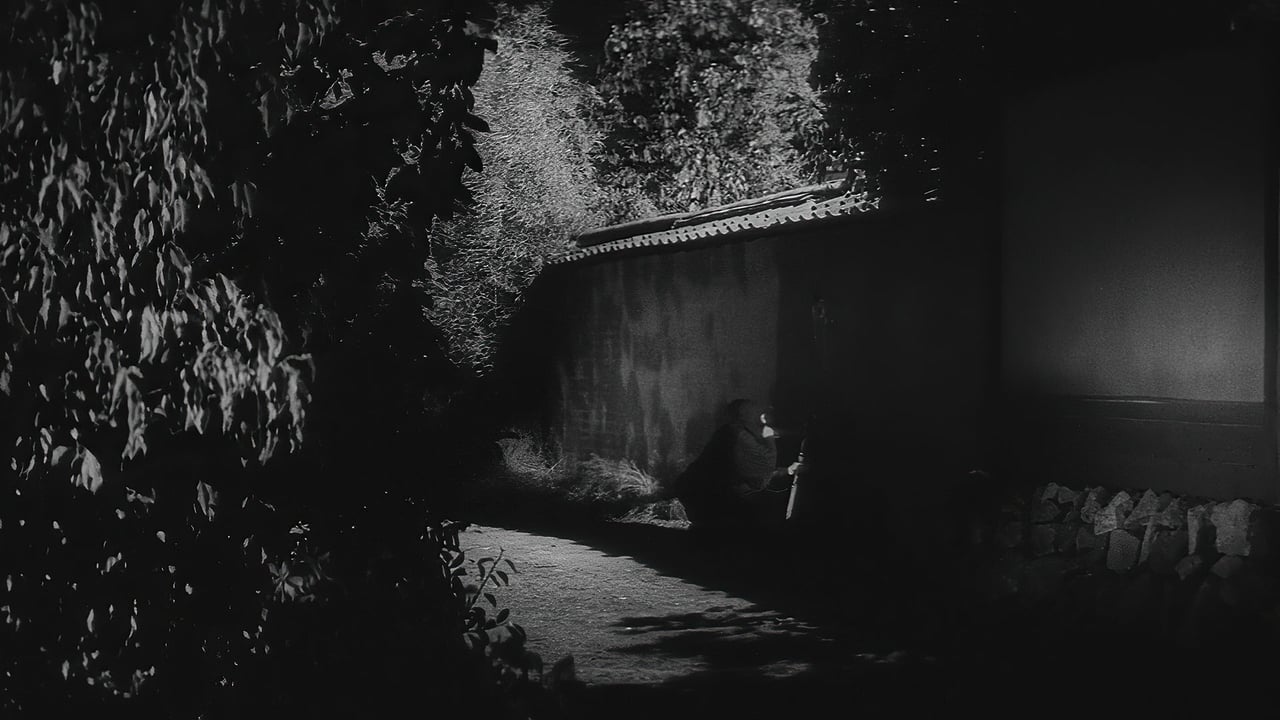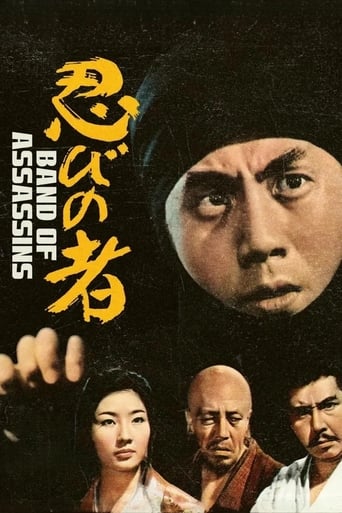Diagonaldi
Very well executed
SunnyHello
Nice effects though.
Matialth
Good concept, poorly executed.
Geraldine
The story, direction, characters, and writing/dialogue is akin to taking a tranquilizer shot to the neck, but everything else was so well done.
Mikesw1234
There are very, VERY many excellent samurai films. It's a shame then, that there are so few good movies focusing on the ninja. At least as far as what's been released in the U.S. anyway. Still, considering just how highly regarded ninja are in American pop culture, it's a mystery why the Shinobi No Mono series isn't more widely known.The series is based loosely on true events and features far more grounded action than Ninja Gaiden fans might expect. After all, the real life ninja were all about infiltration, espionage, sabotage, assassination, and subterfuge with their enemies not knowing what hit them until far too late. Straight combat was strictly a samurai thing.The first three films are part of a single story arc and takes place during Japan's Sengoku (Warring States) Period which lead to Tokugawa Ieyasu becoming the first supreme Shogun. The fourth movie is a stand alone story taking place a number of years later when Ieyasu was consolidating his power and features a different main character (though played by the same lead actor).All in all, the Shinobi No Mono series is definitely worth a watch for ninja fans. Also, anyone interested in Japanese history, or even anyone with a taste for period political thrillers should check it out. We can only hope that the rest of this series will some day be released here.
DICK STEEL
I suppose many of us would have loved the romanticism associated with ninjas, with their famed skills of invisibility, swordsmanship, cunning and a whole host of weaponry and gadgets that add to their element of surprise. If you'd think you know a lot of their modus operandi, then perhaps The Ninjas, aka Shinobi No Mono, would contribute to that wealth of knowledge, and at the same time dispel some of the myths and stories that add to the stature of these masked assassins.If you'd wonder what a ninja does when out of his mask, then the film would have painted a rather mundane picture of the practicing ninjas, who hone their skills in enclaves, and frankly look no more like your usual Samurais, except sans status, and honing their skills ala rebels in hiding at their fortified base, and being skilled assassins for hire to Samurais who need someone to do their dirty work for them (yes, even back then you can outsource your dirty laundry), as they themselves are bounded by the honor code of bushido.The movie doesn't waste time in building up a proper background, but throws you thick into the action. With characters loosely adapted from history, you have Oda Nobunaga, a ruthless warlord on rampaging victories across Japan in an effort to unify the country. Needless to say such aggression doesn't sit well with the able bodied, and 2 clans of ninjas are pitted against each other to see who can carry out a successful mission to stop the warlord. The story centers upon Goemon (Raizo Ichikawa), an up and coming, though ambitious and impatient ninja, who is recognized and granted a promotion (to the back office, away from the battlefield, as an accountant!) but in a moment of lustful folly, becomes the pawn of his master Sandayu (Yunosuke Ito), pledging his life to his master's bidding.So begins Goemon's mission, which includes a ruining of his reputation, and committing acts which defy even the ninja's code of conduct (yes there is one!). In fact, we learn and observe many rules and regulations of ninja-dom, what with the need to disfigure oneself prior to death, and how torture must be endured and death always an option. All these get interpreted through Goemon's ultimate shame in living with his guilt, up until he meets a prostitute called Maki (Shiho Fujimura), who gives him new cause to live, setting the stage for the truth of his double-headed master to be revealed.Shinobi No Mono was credited as the first film to popularize the ninja series of films, and had relatively low key special effects, decided to root itself in more realistic elements, rather than have things like tunnelling through sand dunes, and blink and you miss puffing of smoke. Secret passages, booby traps, poison and darts still remain staple, but don't expect any fancy swordplay as targets get dispatched rather quickly. If you're looking for a climatic ending, then you'll likely be sorely disappointed, as everything goes into a big shebang, lacking in any mano-a-mano opportunities.That said, this film is still rather enjoyable for its shedding of light on these mysterious group who operate in the shadows, and it's not always they have to dress up in black for their operations. It'll look rather dated, but somewhat a refreshing change from current films in its presentation sans the easy way out using tons of computer aided imagery.
massaster760
Shinobi No Mono opens quite simply with a meeting of a garrison of ninja's. Oda Nobunaga (Tomisaburo Wakayama) is ravaging the countryside in a quest for total control of Japan. Fearing his onslaught will mean the demise of the ninja, two rival garrisons attempt to send assassins to dispatch the warlord. The Momichi and Fujiyachi garrisons send their two best students to complete the assassination; Guemon (Raizô Ichikawa) from the Fujibayashi clan, and Yohachi from the Momachi clan. Determined not to be bested by the other clan each Shinobi attempts to kill the evil Nobunaga as quickly as possible.Having never seen any of the series but being familiar with many Samurai movies from the same era, I found Shinobi No Mono to be very similar in form to the traditional Chambara formula... albeit a bit more action packed. However as with most early Chambara, the film features a complicated plot, well-developed characters, and striking imagery courtesy of cinematographer Yasukazu Takemura. The big draw of Shinobi No Mono is the martial arts and the film delivers in that aspect. Being one of the first Ninja movies, the film is packed with fight scenes and cool ninja tricks. Shuriken's are thrown, gunpowder ignited, and grappling hooks are used in ways they weren't intended. The film is particularly interesting because it helped create quite a few modern day movie cliché's.For instance, there is a scene where Guemon tries to dispatch a target by sneaking into his attic, drilling a hole in the roof, dropping a string down, and sending poison down the line in an attempt to land it in the sleeping target's mouth. This scene was later imitated in numerous films including George Armitage's 1997 black comedy, "Grosse Point Blank." Other than that, many of the newer breed of ninja movies feature a lot of the same "secret ninja moves" that were made known in Shinobi No Moni.My only complaint is that sometimes the plot feels needlessly complicated. If your familiar with other films from this era you shouldn't have a problem following the film. But if you're not, you'll probably have to pay close attention because the plot intricacies come fast as the betrayals, set up's, and alliances pile up.Bottom Line- Interesting and complicated seminal ninja film that's as fun as it is action-packed.
johnlewis
The confusion level is very high for the story, but so is the entertainment quotient. This is good fun, in a fast-paced, light drama; but without any of the goofball humour that mars later 1970s Japan samurai pulp films. The elderly leaders of two Ninja clans are actually the same person in disguise. The old man frequently changes disguises and travels to the other hideout during the night to give commands and play his role as the clan leader in each place. In one clan, he enlists and inspires one young ninja aspirant to fight for him in trying to overcome a powerful warlord who is trying to kill off all the ninjas in Japan. The young man ends up being seduced by the old man's young wife. The old man catches him and blackmails the young ninja into asassinating the warlord. One of the most interesting things about this film is watching all the now well-worn cliches of ninja behaviour and methods being introduced in this story: The old man climbs up his walls and in his attic almost like a monkey; the old string and poison assasination trick is used in one place, and some mild humour is added when one adept young ninja keeps accidentally killing small birds when trying to hit various assasination targets with his little star wheels. By the end, most of the confusion is cleared up, and I even found myself wanting to watch it again to understand more of the details. Both the evil old nina leader and the young, ambitious ninja warrior are very convincing in their roles, and are just really fun to watch. On the downside, this movie is too well-made to rate as a good B-movie, but is not really good enough quality to rate it as an "A" movie, either. So the overall feeling is that of a slightly better than mediocre grade A movie. Also, the action is spread a little thin and far between longish drama scenes. Since the drama is on the light side, there is no mesmirising effect as with a good Kurosawa yarn. Overall, however, it is still an entertaining and satisfying movie to watch from an early 1960s ninja filmmaking master.

